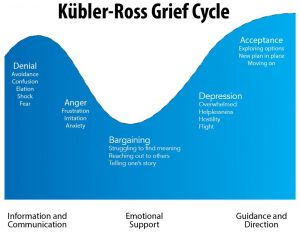STOP READING BY YOURSELF AND JOIN THE ‘BEST BOOK CLUB’ NOW HERE TO MEET AUTHORS AND NEW FRIENDS
STOP TRYING TO ACHIEVE YOUR GOALS BY YOURSELF AND BE COACHED TODAY HERE
DOWNLOAD THIS FREE PDF SUMMARY HERE
CHECK OUT THE FOLLOWING Book | Summaries | Course
YouTube |Spotify | Instagram | Facebook | Newsletter | Website
Kubler-Ross Grief Cycle
What You Should Know About the Stages of Grief
Overview
Grief is universal. At some point in everyone’s life, there will be at least one encounter with grief. It may be from the death of a loved one, the loss of a job, the end of a relationship, or any other change that alters life as you know it.
Grief is also very personal. It’s not very neat or linear. It doesn’t follow any timelines or schedules. You may cry, become angry, withdraw, feel empty. None of these things are unusual or wrong. Everyone grieves differently, but there are some commonalities in the stages and the order of feelings experienced during grief.
Where did the stages of grief come from?
In 1969, a Swiss-American psychiatrist named Elizabeth Kübler-Ross wrote in her book “On Death and Dying” that grief could be divided into five stages. Her observations came from years of working with terminally ill individuals.
Her theory of grief became known as the Kübler-Ross model. While it was originally devised for people who were ill, these stages of grief have been adapted for other experiences with loss, too.
The five stages of grief may be the most widely known, but it’s far from the only popular stages of grief theory. Several others exist as well, including ones with seven stages and ones with just two.
Does grief always follow the same order of stages?
The five stages of grief are:
- denial
- anger
- bargaining
- depression
- acceptance
Not everyone will experience all five stages, and you may not go through them in this order.
Grief is different for every person, so you may begin coping with loss in the bargaining stage and find yourself in anger or denial next. You may remain for months in one of the five stages but skip others entirely.
Stage 1: Denial
Grief is an overwhelming emotion. It’s not unusual to respond to the intense and often sudden feelings by pretending the loss or change isn’t happening. Denying it gives you time to more gradually absorb the news and begin to process it. This is a common defense mechanism and helps numb you to the intensity of the situation.
As you move out of the denial stage, however, the emotions you’ve been hiding will begin to rise. You’ll be confronted with a lot of sorrow you’ve denied. That is also part of the journey of grief, but it can be difficult.
Examples of the denial stage
- Breakup or divorce: “They’re just upset. This will be over tomorrow.”
- Job loss: “They were mistaken. They’ll call tomorrow to say they need me.”
- Death of a loved one: “She’s not gone. She’ll come around the corner any second.”
- Terminal illness diagnosis: “This isn’t happening to me. The results are wrong.”
Stage 2: Anger
Where denial may be considered a coping mechanism, anger is a masking effect. Anger is hiding many of the emotions and pain that you carry. This anger may be redirected at other people, such as the person who died, your ex, or your old boss. You may even aim your anger at inanimate objects.
While your rational brain knows the object of your anger isn’t to blame, your feelings in that moment are too intense to feel that.
Anger may mask itself in feelings like bitterness or resentment. It may not be clear-cut fury or rage. Not everyone will experience this stage, and some may linger here. As the anger subsides, however, you may begin to think more rationally about what’s happening and feel the emotions you’ve been pushing aside.
Examples of the anger stage
- Breakup or divorce: “I hate him! He’ll regret leaving me!”
- Job loss: “They’re terrible bosses. I hope they fail.”
- Death of a loved one: “If she cared for herself more, this wouldn’t have happened.”
- Terminal illness diagnosis: “Where is God in this? How dare God let this happen!”
Stage 3: Bargaining
During grief, you may feel vulnerable and helpless. In those moments of intense emotions, it’s not uncommon to look for ways to regain control or to want to feel like you can affect the outcome of an event. In the bargaining stage of grief, you may find yourself creating a lot of “what if” and “if only” statements.
It’s also not uncommon for religious individuals to try to make a deal or promise to God or a higher power in return for healing or relief from the grief and pain. Bargaining is a line of defense against the emotions of grief. It helps you postpone the sadness, confusion, or hurt.
Examples of the bargaining stage
- Breakup or divorce: “If only I had spent more time with her, she would have stayed.”
- Job loss: “If only I worked more weekends, they would have seen how valuable I am.”
- Death of a loved one: “If only I had called her that night, she wouldn’t be gone.”
- Terminal illness diagnosis: “If only we had gone to the doctor sooner, we could have stopped this.”
Stage 4: Depression
Whereas anger and bargaining can feel very “active,” depression may feel like a “quiet” stage of grief.
In the early stages of loss, you may be running from the emotions, trying to stay a step ahead of them. By this point, however, you may be able to embrace and work through them in a more healthful manner. You may also choose to isolate yourself from others in order to fully cope with the loss.
That doesn’t mean, however, that depression is easy or well defined. Like the other stages of grief, depression can be difficult and messy. It can feel overwhelming. You may feel foggy, heavy, and confused.
Depression may feel like the inevitable landing point of any loss. However, if you feel stuck here or can’t seem to move past this stage of grief, talk with a mental health expert. A therapist can help you work through this period of coping.
Examples of the depression stage
- Breakup or divorce: “Why go on at all?”
- Job loss: “I don’t know how to go forward from here.”
- Death of a loved one: “What am I without her?”
- Terminal illness diagnosis: “My whole life comes to this terrible end.”
Stage 5: Acceptance
Acceptance is not necessarily a happy or uplifting stage of grief. It doesn’t mean you’ve moved past the grief or loss. It does, however, mean that you’ve accepted it and have come to understand what it means in your life now.
You may feel very different in this stage. That’s entirely expected. You’ve had a major change in your life, and that upends the way you feel about many things. Look to acceptance as a way to see that there may be more good days than bad, but there may still be bad — and that’s OK.
Examples of the acceptance stage
- Breakup or divorce: “Ultimately, this was a healthy choice for me.”
- Job loss: “I’ll be able to find a way forward from here and can start a new path.”
- Death of a loved one: “I am so fortunate to have had so many wonderful years with him, and he will always be in my memories.”
- Terminal illness diagnosis: “I have the opportunity to tie things up and make sure I get to do what I want in these final weeks and months.”
The 7 stages of grief
The seven stages of grief are another popular model for explaining the many complicated experiences of loss. These seven stages include:
- Shock and denial. This is a state of disbelief and numbed feelings.
- Pain and guilt. You may feel that the loss is unbearable and that you’re making other people’s lives harder because of your feelings and needs.
- Anger and bargaining. You may lash out, telling God or a higher power that you’ll do anything they ask if they’ll only grant you relief from these feelings.
- Depression. This may be a period of isolation and loneliness during which you process and reflect on the loss.
- The upward turn. At this point, the stages of grief like anger and pain have died down, and you’re left in a more calm and relaxed state.
- Reconstruction and working through. You can begin to put pieces of your life back together and carry forward.
- Acceptance and hope. This is a very gradual acceptance of the new way of life and a feeling of possibility in the future.
As an example, this may be the presentation of stages from a breakup or divorce:
- Shock and denial: “She absolutely wouldn’t do this to me. She’ll realize she’s wrong and be back here tomorrow.”
- Pain and guilt: “How could she do this to me? How selfish is she? How did I mess this up?”
- Anger and bargaining: “If she’ll give me another chance, I’ll be a better boyfriend. I’ll dote on her and give her everything she asks.”
- Depression: “I’ll never have another relationship. I’m doomed to fail everyone.”
- The upward turn: “The end was hard, but there could be a place in the future where I could see myself in another relationship.”
- Reconstruction and working through: “I need to evaluate that relationship and learn from my mistakes.”
- Acceptance and hope: “I have a lot to offer another person. I just have to meet them.”
The takeaway
The key to understanding grief is realizing that no one experiences the same thing. Grief is very personal, and you may feel something different every time. You may need several weeks, or grief may be years long.
If you decide you need help coping with the feelings and changes, a mental health professional is a good resource for vetting your feelings and finding a sense of assurance in these very heavy and weighty emotions.
STOP READING BY YOURSELF AND JOIN THE ‘BEST BOOK CLUB’ NOW HERE TO MEET AUTHORS AND NEW FRIENDS
STOP TRYING TO ACHIEVE YOUR GOALS BY YOURSELF AND BE COACHED TODAY HERE
DOWNLOAD THIS FREE PDF SUMMARY HERE
CHECK OUT THE FOLLOWING Book | Summaries | Course
YouTube |Spotify | Instagram | Facebook | Newsletter | Website














